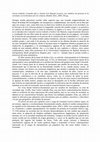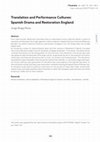Book Reviews by Jorge Braga Riera
Bulletin of Spanish Studies, 97, 2020
Enlaces, número 7, Jul 2007
Martínez de Sousa, José, Diccionario de uso de las mayúsculas y minúsculas, Gijón, Ediciones Trea... more Martínez de Sousa, José, Diccionario de uso de las mayúsculas y minúsculas, Gijón, Ediciones Trea, 2007, 250 pp.
Revista Pygmalion: Revista de teatro general y comparado, 0, 2, 2009
El teatro del Siglo de Oro español nunca ha suscitado demasiado interés en el mundo anglófono.
Atlantis 32.1: 179-184, 2010

Enlaces, 12, Jun 2010
García Gallarín, Consuelo (dir.) y Karlos Cid Abasolo (coord.), Los nombres de persona en la soci... more García Gallarín, Consuelo (dir.) y Karlos Cid Abasolo (coord.), Los nombres de persona en la sociedad y en la literatura de tres culturas, Madrid, Sílex, 2009, 195 pp. Siempre resulta placentero escribir sobre aspectos que, aun rozando tangencialmente las líneas de trabajo del investigador, las enriquecen y complementan. Así sucede con la obra que aquí nos ocupa y que, como bien reza su título (Los nombres de persona en la sociedad y en la literatura de tres culturas) plantea la inagotable cuestión del nombre propio y su presencia en culturas tan distintas entre sí como la románica, la inglesa y la vasca. Tal y como apuntan en la introducción Consuelo García Gallarín y Karlos Cid Abasolo, respectivamente directora y coordinador de este libro amén de autores con voz propia dentro de sus páginas, «el estudio de la función del antropónimo en el proceso de la construcción de la identidad es […] un tema de máximo interés». No andan errados ambos estudiosos, máxime si tenemos en cuenta que el nombre propio, y por ende el de persona, ha concitado en las últimas décadas la atención de las más variopintas disciplinas, desde la literatura hasta la lingüística histórica pasando por la traducción, la pragmática y la sociolingüística, algunas de las cuales tendrán obviamente cabida en esta mimada edición. Así, y a lo largo de seis capítulos o «libros», otros tantos colaboradores, todos ellos profesores de la Universidad Complutense de Madrid, abordan la antroponimia desde perspectivas dispares pero -eso sí-siempre bajo el prisma común y trasversal del tema onomástico.
Estudios de Traducción, 3, Oct 2013
Papers by Jorge Braga Riera

Sendebar, 2024
En las dos últimas décadas los estudios sobre retraducción literaria han adquirido un notable ava... more En las dos últimas décadas los estudios sobre retraducción literaria han adquirido un notable avance, y son variadas las propuestas que incluyen definiciones para este fenómeno e inciden en los elementos que lo propician. No obstante, en el ámbito teatral, apenas si contamos con reflexiones que aborden los factores textuales y extratextuales que provocan la traducción y puesta en escena de una obra previamente traducida (y probablemente también representada) en una cultura meta concreta. Este artículo supone un acercamiento teórico a esta cuestión, al explorar los agentes verbales (lingüísticos, traductológicos) y no verbales (comerciales, personales, ideológicos, escénicos) que favorecen la retraducción y recepción de una obra dramática. El análisis resultante confirma la necesidad de formular una definición de retraducción teatral distinta a la de retraducción literaria que tenga en cuenta las peculiaridades específicas de las artes escénicas.
Forum for Modern Language Studies (Oxford Academic), 2022
ENTI (Enciclopedia de Traducción e Interpretación), 2022

Theatralia, 2021
From 1660 onwards, Restoration dramatists drew on seventeenth-century Spanish theatre in search o... more From 1660 onwards, Restoration dramatists drew on seventeenth-century Spanish theatre in search of new plots and characters that might appeal to London audiences. Despite the socio-historical differences between two distinct theatrical traditions, practitioners managed to turn the foreign plays into actable English texts. By comparing a corpus of classical Spanish plays and their versions in Restoration England, this paper aims to provide some insight into the translation strategies employed. In this sense, two performance- -oriented mechanisms can be distinguished. On the one hand, many elements in the source texts were naturalised to meet the demands of the target culture, as perceived not only in the treatment of rhythm, versification and rhetorical devices but also in action, act-division and characterisation. This domesticating method is also noticeable in how the central motifs of the comedia, i.e. comicality (stage and linguistic), honour and love, were approached. On the other hand, some aspects in the originals (storylines, names and certain stylistic features) were maintained, manifestly showing the Spanishness of the play-text. A contrastive study leads to significant conclusions on the success of these tailor-made, accommodating formulas, and raises questions about the extent to which the translators reach the status of authors by leaving a visible mark on their creations.

Quaderns de Filologia: Estudis Lingüístics, 2019
El proyecto MUST (MUltilingual Student Translation) (Granger y Lefer, 2018: 72) tiene como objeti... more El proyecto MUST (MUltilingual Student Translation) (Granger y Lefer, 2018: 72) tiene como objetivo compilar un corpus paralelo multilingüe de traducciones realizadas por estudiantes sin experiencia en el campo de la traducción. En el marco de este proyecto, el equipo UCMA (de la Universidad Complutense de Madrid) aporta un subcorpus bilingüe de textos especializados traducidos por estudiantes en los ámbitos audiovisual y de las humanidades, entre otros. Teniendo en cuenta las cinco subcompetencias propias de la adquisición de la competencia traductora (lingüística, extralingüística, de transferencia, profesional, psicofisiológica y estratégica [PACTE, 2001 y 2003]), este estudio persigue detectar las debilidades y fortalezas presentes en las tareas de traducción inglés-castellano de los estudiantes. Para ilustrarlas, se ha utilizado el sistema de anotación TAS propuesto por Granger y Lefer (2018) y Granger, Lefer y Penha Marion (2018), junto con una muestra de textos humanísticos a cargo de traductores en formación universitaria (postgrado) que se encuentran almacenados en el corpus UCMA.

In recent years, the notion of paratranslation has grown in Translation Studies, particularly in ... more In recent years, the notion of paratranslation has grown in Translation Studies, particularly in the literary field. Nevertheless, little attention has been paid to the effect that paratextual components — peritextual and epitextual — (Genette 1997) may have on the rendering of theatrical texts into another language, especially if these texts are intended for performance. This article will seek to deal with the issue of paratranslation in the theatre, and more specifically with the potential influence of epitexts on the reception of a particular stage play in a different culture, as well as with the significance of the figure of the translator in the process. Two recent British performances of the Spanish classic Life is a Dream, based on two different translations, have been used by way of example. The results will show how reviews, webpages, videos, posters, flyers and programmes can add to the manner in which a particular play is perceived in the eyes of its target audiences, and to what extent the final outcome may be felt as part of the recipient theatrical culture.
Speech, Language and Hearing, 2018
Thomas Hardy's use of the Wessex county dialect plays a key role in much of his narrative fiction... more Thomas Hardy's use of the Wessex county dialect plays a key role in much of his narrative fictional dialogue, as shown in Tess of the D'Urbervilles (1891). By analysing the two existing Spanish translations of this novel (one by M. Ortega y Gasset, first published in 1924 and recently reedited and revised by Carmen Criado; the other by Javier Franco Aixelá in 1994), this paper is intended to illustrate how the grammatical structures, vocabulary , and phonological characteristics of such dialect are rendered into Spanish. Attempts will be made to show the mechanisms that the translators resort to in order to convey those dialectal features and the extent to which they have managed to portray both Tess's rural quality and social evolution as reflected in her idiom.
Babel AFIAL, 2013
In the last few years Spanish seventeenth-century drama has aroused the interest of a group of tr... more In the last few years Spanish seventeenth-century drama has aroused the interest of a group of translation scholars and practitioners, both in Great Britain and America. This article is intended to show some of the procedures used by contemporary translators of the most international Spanish classical play: La vida es sueño. For this purpose, and thanks to a brief corpus of plays translated into English that have been first staged in the last two decades, attention will be paid to how some of the most recurrent topics of our comedia (that is, honour, decorum and the view of women) are transferred to a different period, culture and space. Thus, an analysis of the target texts reveals the use of a wide range of translation mechanisms to guarantee a favourable reception of the final product.

Uploads
Book Reviews by Jorge Braga Riera
Papers by Jorge Braga Riera
This paper is intended to provide some insight into the relevance of extralinguistic factors in the translation of dramatic texts. By taking English versions of seventeenth-century Spanish plays as a source for exemplification, we will see how rhythm, rhyme, body language, light, costume and setting may have a say in the transposition of drama. We will also consider other factors such as censorship, criticism or the translator's visibility and reputation. Additionally, some attention will be paid to the
procedures of domestication and/or exotization intended to guarantee the acceptance of the resulting product in the recipient culture.
no “traducción”, este artículo pretende dejar constancia de la utilización de estos y otros conceptos semejantes en el ámbito dramático, así como plantear el debate sobre la necesidad de
unificar criterios terminológicos dentro de los llamados Estudios de Traducción Teatral.
phasal analysis of lectures as proposed by Young (1994). On the other, the lecturers’ recognition of their role as translators in CLIL lessons has been considered as well. To this double aim, lectures belonging to the fields of Physics and Engineering have been recorded, transcribed and analysed, with special attention being paid to phasal division. As for our next goal, the answers to a 26-item questionnaire addressed to lecturers and containing reflections on their translating activity have also been
thoroughly studied. Findings show that translation does indeed play a pivotal role in the linguistic quality of lectures, with those phases in which translation applies resulting in lower levels of L1 interference. Further research on this area may indeed determine how valuable translation skills are in order to develop a higher efficiency in the preparation and delivery of university lectures.
Madrid: Escolar y Mayo (2015). ISBN: 978-84-16020-44-7.